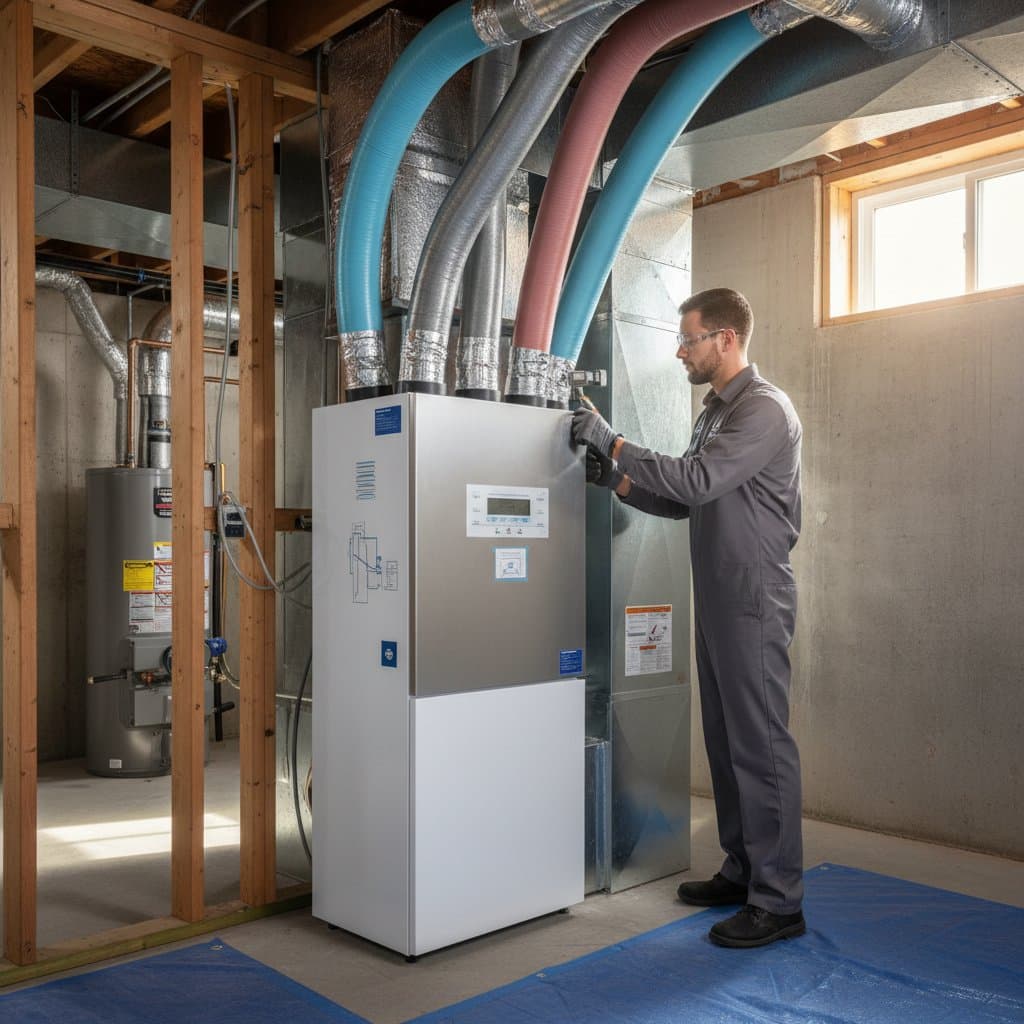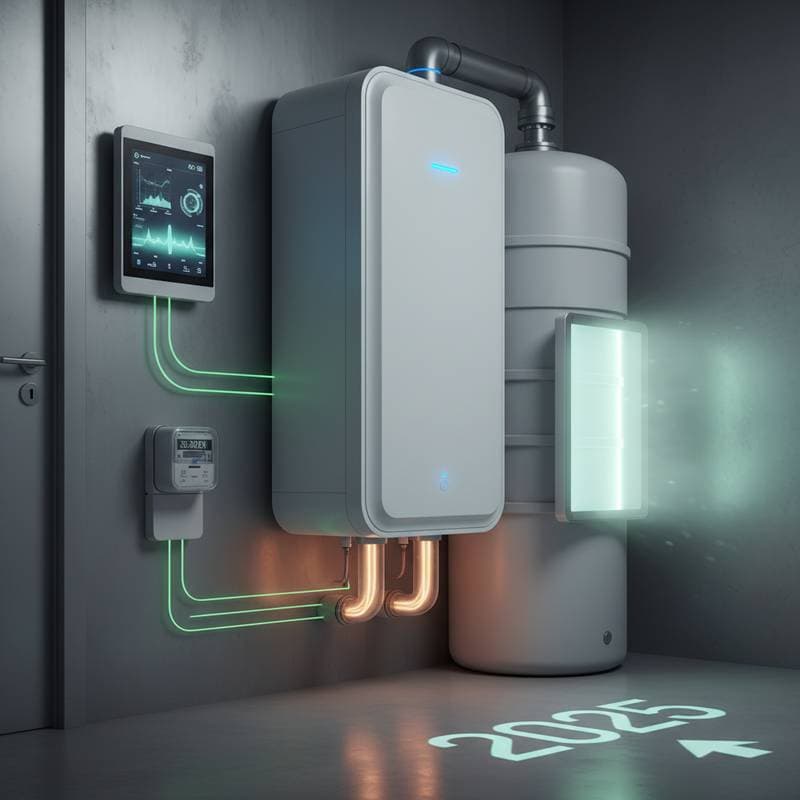Reduce Cooling Expenses by 35 Percent with Humidity Control
Summer heat waves increase reliance on air conditioners, which elevates energy expenses rapidly. Homeowners often overlook how elevated humidity intensifies the perception of warmth. Effective humidity management permits higher thermostat settings for equivalent comfort levels, yielding energy reductions of up to 35 percent. This guide explains humidity control fundamentals, its influence on cooling expenses, and the advantages of integrating a whole-home dehumidifier for enhanced comfort and financial benefits.
Understanding Humidity Control
Humidity control involves regulating indoor air moisture to optimal levels, generally between 30 percent and 50 percent. Levels exceeding this range create a clammy atmosphere, even at moderate temperatures. The human body relies on sweat evaporation for cooling, a process hindered by saturated air, leading to discomfort and the need for lower thermostat adjustments.
A well-engineered humidity control system extracts surplus moisture, enabling air conditioners to operate with greater efficiency. Such systems also prevent moisture-related problems, including mold growth, mildew accumulation, and structural damage to wooden elements.
The Impact of High Humidity on Perceived Temperature
A thermostat reading of 75 degrees Fahrenheit can feel like 85 degrees in humid conditions, a phenomenon known as the heat index. This occurs because humidity impairs sweat evaporation, causing the body to retain heat and prompting users to decrease temperature settings. Consequently, air conditioners endure increased workload, resulting in higher utility bills.
Reducing humidity maintains comfort at elevated thermostat levels. This adjustment alone generates significant energy conservation over the season.
Indicators of Excessive Indoor Humidity
A muggy atmosphere or persistent air conditioner operation without adequate relief signals high humidity. Consider these common indicators:
- Damp or sticky sensations persist despite active air conditioning
- Condensation appears on windows or mirrors
- Musty smells emerge in enclosed areas like closets, basements, or bathrooms
- Wooden surfaces such as floors or furniture exhibit warping or swelling
- Visible mold or mildew develops on walls or ceilings
- Thermostat requires unusually low settings for comfort
Multiple signs suggest the cooling system contends with moisture overload. A whole-home dehumidifier restores balance and eases the burden on the air conditioner.
How Humidity Influences Cooling Expenses
Humid air demands additional effort from cooling systems to eliminate both heat and moisture. While air conditioners perform incidental dehumidification, they lack optimization for this task, consuming extra energy and accelerating wear.
Excess humidity contributes to higher costs in these ways:
- Extended Operating Cycles
Prolonged runtime is necessary to extract moisture, boosting electricity consumption. - Lowered Thermostat Preferences
Users compensate for discomfort by reducing temperatures, intensifying system demands. - Diminished Operational Efficiency
Moisture can lead to evaporator coil icing, impairing cooling effectiveness. - Accelerated Component Degradation
Frequent cycling hastens wear, elevating repair and maintenance expenditures.
A dedicated dehumidifier allows the air conditioner to prioritize temperature regulation. This results in reduced runtime, lower energy demands, and minimized mechanical strain.
Functionality of Whole-Home Dehumidifiers
Whole-home dehumidifiers integrate with HVAC systems to regulate moisture across the entire residence. Unlike standalone portable models limited to single rooms, these units utilize existing ductwork for comprehensive coverage and automatic humidity adjustment.
Operational Mechanism
- Air Acquisition
Moist indoor air enters via return ducts into the dehumidifier. - Moisture Extraction
The device condenses water vapor and directs it to a drainage outlet. - Air Redistribution
Treated dry air circulates through supply ducts, ensuring uniform comfort.
This automated process operates with minimal noise, sustaining ideal humidity without manual intervention. Drier air enhances the cooling sensation, supporting higher thermostat settings without discomfort.
Primary Advantages of Whole-Home Humidity Management
Humidity control extends beyond expense reduction, elevating indoor environment quality, comfort, and durability.
1. Substantial Energy Conservation
Optimal humidity enables thermostat increases while preserving coolness. Homeowners frequently achieve savings up to 35 percent on cooling expenses.
2. Superior Comfort Levels
Dehumidified air feels refreshing and light, eliminating residual clamminess from air conditioning alone.
3. Improved Air Quality
Reduced moisture inhibits mold, dust mites, and allergens, benefiting respiratory health for occupants.
4. Extended HVAC Durability
Shorter air conditioner cycles from alleviated moisture load decrease operational hours, prolonging equipment life.
5. Property Preservation
Controlled humidity safeguards wooden flooring, furnishings, and finishes from moisture-induced deterioration.
Determinants of Dehumidifier Installation Expenses
Whole-home dehumidifier costs fluctuate based on multiple variables, typically ranging from several hundred to thousands of dollars. Regional pricing and installer rates contribute to variations. Key influences include:
- Capacity and Scale
Larger residences necessitate robust units to process greater moisture volumes. - Integration Requirements
Modifications to ducts or electrical systems may incur additional charges. - Model Specifications
Advanced, energy-efficient units with smart features command higher initial prices but yield long-term savings. - Installation Labor
Expert setup covers drainage, wiring, and connections, impacting overall expenditure. - Ongoing Support Options
Extended warranties or service plans enhance value through sustained performance.
Although an upfront investment, returns from reduced cooling costs, improved comfort, and equipment longevity recoup expenses within several seasons.
Self-Managed Versus Professional Humidity Solutions
Portable dehumidifiers or basic ventilation improvements appeal to some for humidity management. These methods suit isolated areas but fall short for comprehensive home needs. Evaluate options to determine suitability.
Manageable Self-Actions
- Activate exhaust fans during showers or cooking in bathrooms and kitchens
- Seal gaps around windows and doors to prevent humid air infiltration
- Maintain closed windows during high-humidity periods
- Replace HVAC filters monthly to optimize airflow
- Employ ceiling fans to promote even air movement
These measures complement cooling systems yet address only surface-level humidity.
Professional Intervention Thresholds
Persistent multi-room humidity warrants HVAC specialist involvement. Experts provide:
- Precise humidity measurements using diagnostic equipment
- Evaluation of air conditioner sizing and performance
- Tailored dehumidifier recommendations based on home specifics
- Secure integration of electrical and drainage components
- Seamless incorporation into current HVAC infrastructure
Professional execution guarantees safety, efficiency, and reliability.
Dehumidifier Installation Overview
Engaging a qualified HVAC technician for whole-home dehumidifier setup follows a structured approach:
- Evaluation and Specification
Inspection includes humidity assessment and capacity determination for the property. - Equipment Choice
Options align with home dimensions, financial constraints, and performance objectives. - Setup and Connection
Integration involves duct attachment, drainage configuration, and electrical provisioning. - Verification and Adjustment
Testing confirms humidity regulation, airflow integrity, and setting optimization. - Care Instructions
Guidance covers routine tasks like filter maintenance and annual servicing schedules.
Thorough installation delivers reliable humidity management and peak energy efficiency throughout the year.
Common Inquiries
In What Manner Does Humidity Control Decrease Energy Expenses?
Dehumidification cools the sensation of air, permitting thermostat elevation without comfort loss. This shortens air conditioner runtime, potentially reducing cooling costs by 35 percent.
Do Air Conditioners Independently Manage Humidity?
Cooling processes incidentally remove moisture, yet air conditioners prioritize temperature over precise humidity control. Dedicated units perform this task more effectively, preserving AC longevity.
Does a Whole-Home Dehumidifier Justify Its Cost?
Affirmative, particularly in moist regions. Enhanced comfort, energy reductions, and maintenance savings establish it as a prudent investment.
What Maintenance Frequency Applies to Whole-Home Dehumidifiers?
Annual professional servicing is recommended, involving coil cleaning, filter inspection, and drainage verification for optimal function.
Can a Dehumidifier Over-Dry the Home?
Contemporary systems self-regulate to ideal levels. Adjustable controls prevent excessive drying while ensuring comfort.
Steps to Achieve Cooler Summers
Effective humidity management transforms summer cooling without excessive air conditioner dependence. It fosters comfort, protects residences, and curbs expenses simultaneously. A whole-home dehumidifier operates discreetly, optimizing HVAC performance through moisture regulation.
Persistent stickiness, nonstop AC cycles, or rising bills indicate humidity as the underlying issue. Arrange a professional assessment to measure levels and identify suitable dehumidification strategies. Implement humidity control for a refreshed home and reduced seasonal expenditures.





